| Posted: May 20, 2014 | |
Nanotechnology in food quality control: Preventing food from biting back (page 2 of 4) |
|
| Recently, MIT chemistry professor Timothy Swager and his associates have developed an inexpensive (may cost approximately $1) CNT-based sensor. To fabricate the sensing device, sensing material (CNTs) was compressed into a pencil and then drawn between gold electrodes printed on a paper substrate. This sensor can detect the amount of ethylene gas as low as 0.5 ppm and researchers have tested it on various fruits such as banana, orange, avocado, pear, and apple to measure the fruit ripening. These sensors can be attached to the fruit cardboard boxes and scanned with a manually held device that would suggest grocers to put food items on sale before they get too ripened (Fig. 2). This patent pending technology might lead to the launch of a start-up company, ‘C2Sense’ in the first quarter of 20146. | |
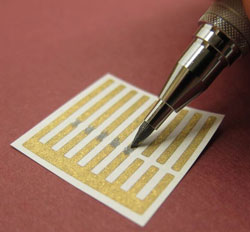 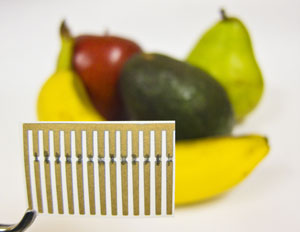
|
|
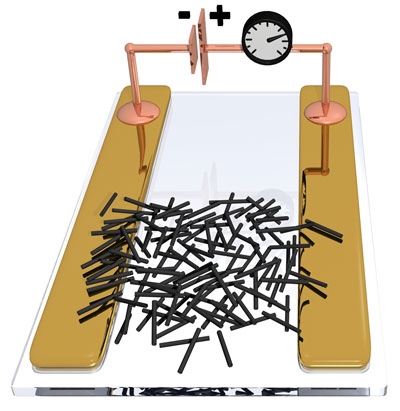 |
|
| Fig. 2: Top left: A photo illustrating sensor fabrication method: sensing material is compressed into a pencil and drawn between gold electrodes on a paper substrate. Top right: Sensor prototypes in front of fruits. Bottom: Schematic drawing of sensor showing two gold electrodes with the CNT sensing material in between. (Image courtesy: Prof. Dr. Timothy M. Swager,´Massachusetts Institute of Technology, Cambridge) | |
| Rice University scientist Ned Thomas and his team have made an inexpensive photonic gel that can be placed inside the food packages to monitor environmental changes due to contamination, aging or temperature variations. This micron-thick gel is made from the nanoscale layers of hydrophobic and hydrophilic polymers, which remain diffused in liquid solution but self-assemble into layered nanopancakes/thin films when applied to a surface. In the presence of any contaminant, the film colour changes and becomes transparent again after washing out the contaminants (Fig. 3). This photonic gel nanosensor can also be tuned to reflect different colours against various contaminants/chemicals/environmental conditions7. | |
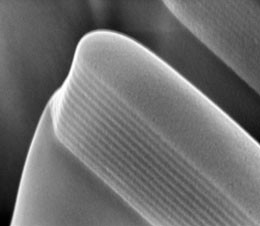 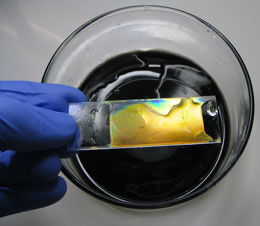
|
|
| Fig. 3: Left: Nano-sized layers of polymeric molecules that self-assemble into a photonic gel. Right: Photonic gel changes colour in response to a chemical. (Image courtesy: Thomas Lab/Rice University and Joseph Walish/MIT) | |
| Norwegian company, Thin Film Electronics (http://www.thinfilm.no) in partnership with PST Sensors (http://www.pstsensors.com) an off-shoot of the University of Cape Town, South Africa has developed self-powered smart nanosensor labels to monitor temperature variations in perishable goods including food items. Printed with ink containing silicon NPs, the core of this nanosensor label is a negative temperature coefficient (NTC) thermistor whose resistance decreases when temperatures goes up. Additional circuitry for wireless communication and timer function can also be added to nanosensor labels and commercial availability is expected in the 4th quarter of 20148,9. | |
| Detection of Pesticides, Adulterants & other Organic Molecules | |
| The global pesticide market is expected to grow at CAGR 3.6% to reach $51 billion in 201410, indicating the growing use of harmful chemicals in agriculture sector to increase crop yields. The pesticide poisoning might travel up to the various interlinked food chains posing a challenge for food security measures to look for more reliable sensing platforms. | |
| Coming to the rescue, nanotechnology presents various ultra-sensitive and highly selective analytical methods for contaminant residue analysis in food items. IPI, Singapore (under Ministry of Trade and Industry of Singapore) has a technology in-offer based on nano ZrO2, to detect different pesticides in food items having various advantages such as ultrasensitivity (up to ppb level), instantaneous response time, environment friendliness, selectivity, etc11. | |
| Gold-coated SERS-active nanosubstrates have been used by a research team from University of Missouri, USA and Jiangnan University, China to detect various pesticides prominently used in tomato and apple plantations. This SERS measurement system was found to have detection limit comparable to the maximum allowed residue limits established by the World Health Organization (WHO) and the Food and Agriculture Organization of the United Nations (FAO)12. | |
| US based Hewlett-Packard Company is developing a gold nanofinger SERS system having detection limit lower than the EPA regulated limits for sensing melamine content in milk adulteration and chlropyrifos (a pesticide residue) content in citrus fruits13. | |
| Continue to next page (3 of 4) | |
|
Become a Spotlight guest author! Join our large and growing group of guest contributors. Have you just published a scientific paper or have other exciting developments to share with the nanotechnology community? Here is how to publish on nanowerk.com. |
|
